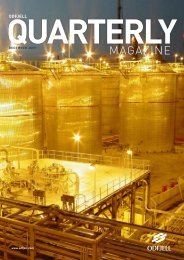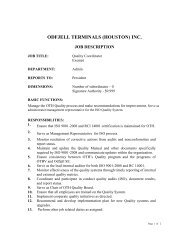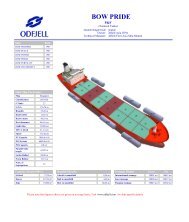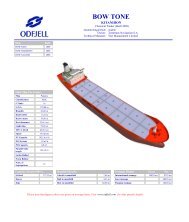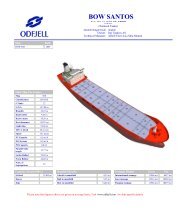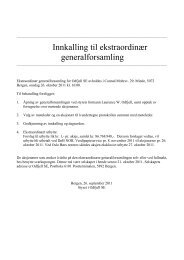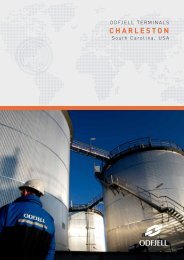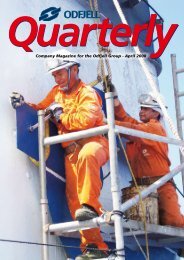Odfjell SE Annual Report 2012
Odfjell SE Annual Report 2012
Odfjell SE Annual Report 2012
Create successful ePaper yourself
Turn your PDF publications into a flip-book with our unique Google optimized e-Paper software.
chemical transportation<br />
and storage<br />
Chemicals are an integral part of modern life, and our<br />
societies and most industries now depend on products<br />
derived from such commodities. The sector has enjoyed<br />
solid growth worldwide for many years. Developing economies<br />
around the world are now fuelling major increases<br />
in both consumption and production of chemicals.<br />
The largest chemical segment, both in terms of total<br />
volumes and product diversity, is the petrochemicals.<br />
Historically, the production of petrochemical products was<br />
based in the US and Europe. Gradually production capacity<br />
has been growing in the Far East, South America, South<br />
Africa and particularly in the Middle East. In recent years,<br />
China has developed into a major chemical producer and<br />
gradually also an exporter. New plants in these regions are<br />
mostly designed for the production of base chemicals or<br />
‘building blocks’, whilst the production of derivatives and<br />
speciality chemicals is still mostly concentrated in the US<br />
and Europe. However, manufacturing companies in the<br />
Middle East are investing in developing their business in<br />
the direction of further down- streaming.<br />
Chemical production facilities have traditionally been<br />
located in areas with easy access to raw materials.<br />
Historically, much petrochemical production was coalbased.<br />
Naphtha, a derivative from crude oil refining, is<br />
another raw material that is widely used, particularly in<br />
Asia and Europe. Ethylene and propylene, the two main<br />
building blocks for the chemical industry can be derived<br />
both from naphtha and from natural gas. New plants are<br />
being built in areas where natural gas is readily available,<br />
which explains the massive increase in production capacity<br />
in the Middle East and in recent years also in the US.<br />
The petrochemical industry is truly international with both<br />
production and consumption in all regions of the world,<br />
and many petrochemical companies have become global<br />
in their market approach. As a result, the petrochemical<br />
industry has a constant demand for logistics service<br />
providers capable of offering different types of storage<br />
and transportation. As of today, only a limited number of<br />
logistics service providers operate globally. Some specialise<br />
in one type of service, for instance bulk liquid storage. Most<br />
shipping and storage companies operate locally or within<br />
a certain region, and there are only a limited number of<br />
companies with the ability to offer a multiple of different<br />
services on a global basis.<br />
<strong>Odfjell</strong> is one of few companies offering a worldwide network<br />
of both bulk shipping and storage services. Operating<br />
through offices at central locations around the world, <strong>Odfjell</strong><br />
is a major player in the chemical tanker segment operating<br />
in all major trade lanes. Whilst chemical tankers only<br />
represent a small percentage of the total world fleet of<br />
ocean-going tankers, for which the main cargo is crude<br />
oil, there is nevertheless a considerable interplay between<br />
different tanker segments. As far as the chemical tanker<br />
market is concerned, handysize and medium range product<br />
tankers have an impact in the 35–50,000 DWT size range<br />
employed for carriage of clean petroleum products such<br />
as naphtha, gasoline, diesel and gas oil.<br />
Chemical tankers are generally designed and constructed<br />
for handling a multiple of different types of cargoes<br />
simultaneously and as such combines different customers’<br />
requirements under single voyages. Different customers’<br />
products are always kept segregated. Chemical tankers<br />
are often split into two different categories; ships with all<br />
or the majority of cargo tanks made of stainless steel or<br />
ships with only coated tanks.<br />
Ships with coated tanks are typically engaged in carriage of<br />
commodity-type chemicals, clean petroleum products and<br />
vegetable oils. Important trades for coated chemical tankers<br />
are with full loads of commodity-type chemicals from<br />
Northwest Europe, the US or the Middle East to different<br />
destinations in the Asia/Pacific region. Backhaul cargoes<br />
are often vegetable oils, molasses or clean petroleum<br />
products to Europe or the US.<br />
Ships with cargo tanks made of stainless steel are often<br />
built to handle a higher number of different products. These<br />
organic chemicals<br />
raw materials<br />
Coal<br />
Gas<br />
Crude oil<br />
›<br />
basic products<br />
›<br />
Derivatives<br />
›<br />
BTX<br />
EDC<br />
Ethylene<br />
Styrene<br />
Propylene<br />
Glycol<br />
Methanol<br />
MTBE<br />
Butadiene<br />
Industrial alcohols<br />
Polyester<br />
End products<br />
Paint<br />
Fibres<br />
Plastics<br />
Detergents<br />
Oil additives<br />
Rubber<br />
82<br />
odfjell annual report <strong>2012</strong>



